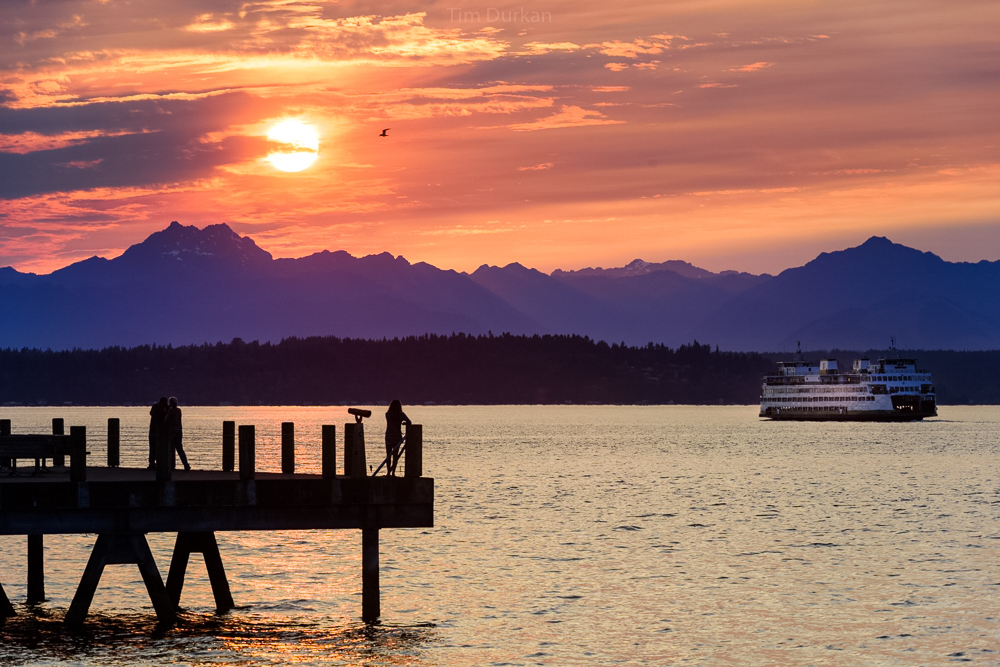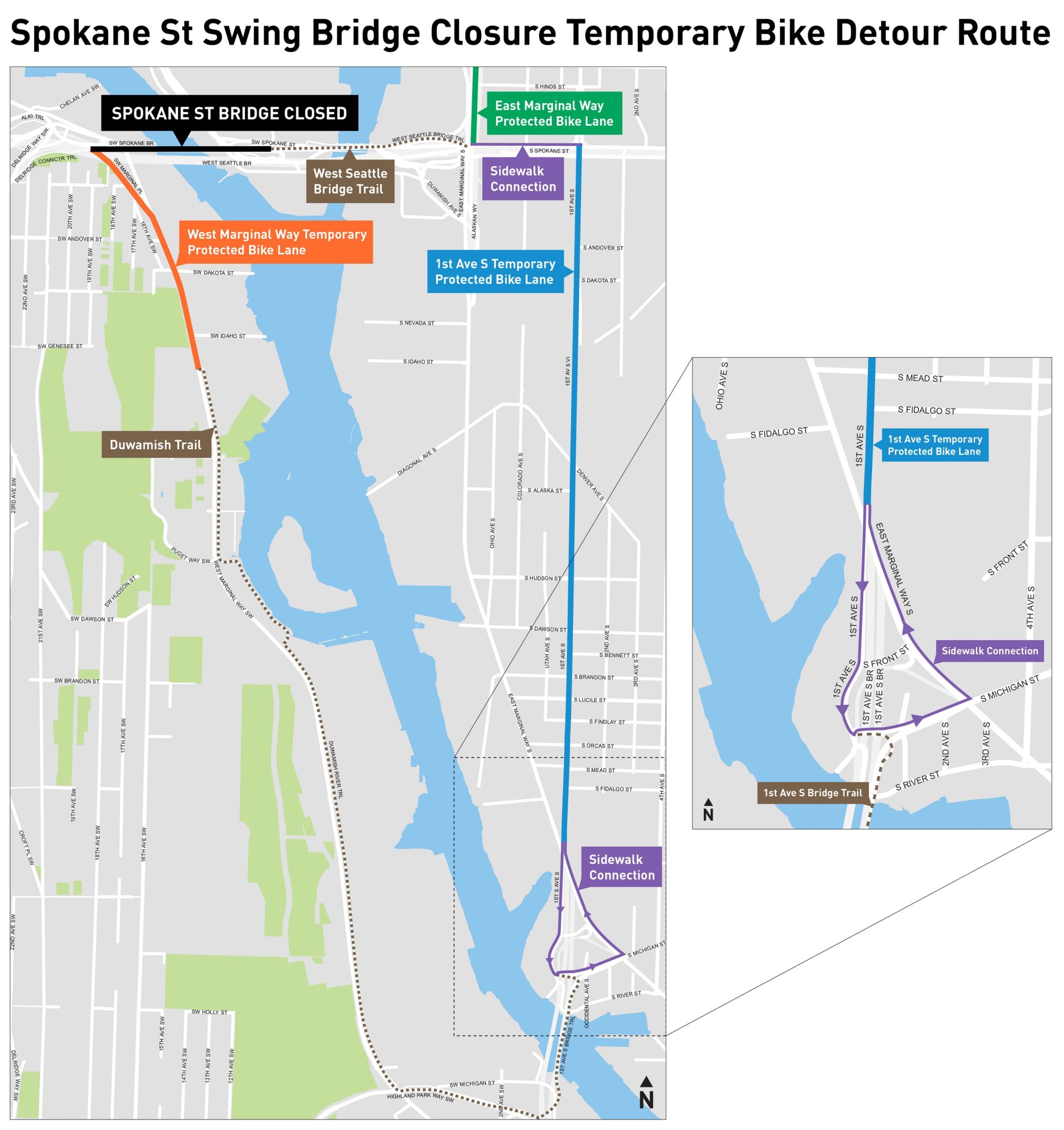
Related Updates:
Bridge repair update: Crews have repaired 500 feet of damaged power conduit on the Spokane St Swing Bridge and are preparing to remove a damaged 15,000-pound hydraulic turning cylinder. Read more.
Read about other resources to get around during the Spokane St Swing Bridge closure.
This is part of a series of updates about our urgent response to the ongoing Spokane St Swing Bridge closure. Click here to see all updates on this topic.
Summary:
- Status at-a-glance:
- Complete: Cleared windstorm debris, installed detour route signs, and reviewed asphalt conditions
- Complete: Installed No Parking signs along detour route segments
- Underway: Preparations to install temporary protected bike lanes along portions of West Marginal Way SW and 1st Ave S
- Ahead: Temporary protected bike lanes in place (to be installed beginning Wednesday, Jan. 4)
- Ahead: Temporary free transit rides on the bus & West Seattle Water Taxi (stay tuned)
- Reminder: Stay alert and use extra caution when traveling through industrial areas
- Read more: Click on the links below for additional details:
As our engineers and technical experts continue to make progress repairing the Spokane St Swing Bridge (Low Bridge), we also have a mobility team addressing the closure’s impact on freight movement and people who bike, walk and roll. We are working to enhance the bike detour route by building temporary protected bike lane segments on West Marginal Way SW and 1st Ave S.
We have been sequentially and intentionally working to enhance the bike route over the past week. Our first step after the bridge closure was to clear windstorm debris, manufacture and install detour route signs, and review the asphalt condition to see if spot improvements were needed.
This week, we are converting sections of W Marginal Way SW and 1st Ave S curb lanes to temporary protected bike lanes using cones, barrels, paint, and signs. The temporary bike lanes will remain until the Spokane St Swing Bridge reopens. We continue to procure traffic control devices and finalize the traffic control plan. We plan to begin installing the bike lanes on Wednesday, Jan. 4.

What to expect
No Parking signs were placed on Friday, alerting businesses to expect a change. Since then, we have worked to secure the equipment to install the detour, including 1,700 traffic cones, and manufacturing additional signs. Starting Wednesday, you will see us working in the curb lanes.
While the temporary bike lanes are in place, 1st Ave S will have one general-purpose traffic lane in each direction, a center turn lane, and one bike lane in each direction. As possible, existing on-street parking will remain but be restricted near driveways to help people biking and driving more easily see each other. In two instances at the north and south ends, people on bikes will have to use the sidewalk—see map above. You may wish to get off your bike and walk it through these areas with pedestrians.
We will also convert the southbound general-purpose travel lane at the northern segment of West Marginal Way SW to a temporary protected bike lane. We expect this to have a minimal impact on people driving, as this is not a through-lane.
We will check the detour twice daily to reset cones, barrels, or signs that may have shifted while the temporary bike lanes are in operation.
What’s next
Safety. While people adjust to detours, stay alert and cautious while traveling. All users should avoid making unexpected movements and avoid distractions like cell phones.
Be Alert. People biking and driving trucks should be very careful when using this detour route, as trucks can have limited visibility.
Transit. We are also working with King County Metro to make riding transit even easier for people by preparing to offer temporary free rides on buses and the West Seattle Water Taxi during the remainder of the low bridge closure. These rides will be funded by the Seattle Transit Measure, passed by Seattle voters in 2020. Please stay tuned for additional details on how to sign up later this week.
Future Detour Planning. Creating this temporary bike lane detour will help us to be more agile and able to consider similar detours during planned low bridge closures and at other locations.
Citywide Bike Network. We have many projects underway to continue building a bike network and reduce the need for detours when bridges or streets are closed for repair. This year we’ll break ground on the E Marginal Way Corridor Project. This project improves the street for trucks, builds a 2-way protected bike lane, replaces a water main, and more.
You can participate in designing a protected bike lane connecting Georgetown to Downtown. This bike lane is the final link in a system of regional bike trails, including the Green River Trail and South Park to Georgetown Trail, providing north-south bike travel between Seattle and S King County.
In late October and early November 2022, we reduced W Marginal Way SW to three travel lanes and a center turn lane for 0.6 miles from SW Marginal Pl to the Duwamish Longhouse. The data collected will help inform work to convert a curb lane to a two-way Protected Bike Lane. The temporary bike lane will help also help define the final design.
Freight. It is important to remember if you got it, a truck brought it to you. Keeping our freight providers moving is also an essential piece of what we do. We’ve turned a signal at West Marginal Way SW (truck flyover to Terminal 5) and SW Spokane St (eastbound approach to Low Bridge) intersection to flashing to facilitate movement to and from Terminal 5. We are also considering additional signs to clarify access via the high bridge to the Terminal 5 flyover.
We recognize this has been a challenging time for travelers, especially coming shortly after the West Seattle High-Rise Bridge closure. We are committed to continually enhancing safety and realize that these adjustments are a necessary part of the response to this bridge closure. Since more low bridge closures are planned for repairs in 2023, we will use the lessons from recent experience to inform temporary enhancements like this during future closures.
Stay informed:
- Email: westseattlebridge@seattle.gov
- Phone: (206) 400-7511
- Sign up for email updates: https://public.govdelivery.com/accounts/WASEATTLE/subscriber/new?topic_id=WASEATTLE_270
- Web: https://www.seattle.gov/transportation/projects-and-programs/programs/bridges-stairs-and-other-structures/bridges/west-seattle-bridge-program/spokane-st-swing-bridge-improvement-projects